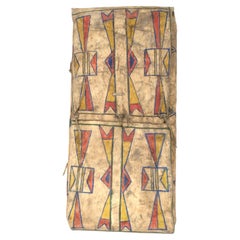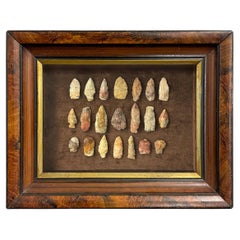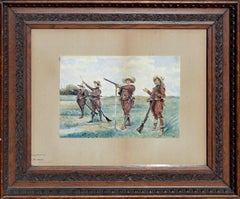David Cook Galleries
to
338
199
63
39
37
33
29
27
24
21
20
13
7
5
3
2
2
1
1
1
1
2
2
1
1
1
Period: Late 19th Century
Morning Near Arizona, 1880s Summer Southwestern Desert Landscape Drawing
By George Elbert Burr
Located in Denver, CO
Morning Near Arizona, (Desert Landscape) is an original color pencil drawing from 1888 by George Elbert Burr (1859-1939). Portrays a spring/summer landscape with a tree and fauna, cl...
Category
1880s American Impressionist Landscape Drawings and Watercolors
Materials
Archival Paper, Color Pencil
Antique Beaded Child's Dress & Leggings, Sioux (Plains Indian) circa 1900, blue
Located in Denver, CO
Sioux child's dress with matching leggings. Created by hand with native tanned hide and beaded with glass trade beads in blue, white, red, pink and green. Pictorial design elements i...
Category
Antique Late 19th Century American Native American Native American Objects
Materials
Hide, Beads
Antique Leggings 1880s Southern Arapaho Plains Native American Hide Fringe Beads
By Native American Art
Located in Denver, CO
Museum quality Southern Arapaho (Hinono’ei) Native American Plains Indian leggings circa 1880s. Constructed of dyed native tanned hide with viridian green dye and ochre yellow embel...
Category
Antique Late 19th Century American Native American Tribal Art
Materials
Hide, Beads
1870s Transitional Plateau Rawhide Parfleche Envelope with Geometric Patterns
By Plateau Indians
Located in Denver, CO
A parfleche container in an envelope form, finely painted in an abstract design. Makes a stunning wall hanging alone or in a grouping with other parfleche or can be placed on a shelf or Stand.
This was created by a North American Indian living in the Plateau cultural area - encompassing portions of what is now northern Idaho, western Montana, northeast and central Oregon, eastern Washington and southeast British Columbia. The tribes from this region include Kalispel, Flathead, Kutenai, Palus, Coeur D'Alene and Nez Perce.
Parfleches are rawhide containers which were fundamental to the Plains way of life. Functioning essentially as protective travelling suitcases, they enabled the nomadic tribes to effectively pursue buffalo herds and migrate between seasonal camps. So critical were they to a nomadic existence that over 40 tribes are known to have historically produced parfleches. Collectively, these tribes inhabited an area which encompassed the entirety of the Plains, as well as the parts of the Southwest, the Transmontane and Western Plateau regions. Parfleches were, out of necessity, robust and versatile objects. They were designed to carry and protect within them anything from medicinal bundles to seasonal clothing or food. In fact, it was because of the containers’ robusticity and variety that parfleches earned their name in the Anglo world. Derived from parer (to parry or turn aside) and fleche (arrow), the word parfleche was coined by 17th century French Canadian voyageurs and used to describe indigenous objects made from rawhide. Despite their common utilitarian function, parfleches served as one of the major mediums through which Plains Indian tribes could develop their long-standing tradition of painting. In fact, it is in large part due to the parfleche that tribal style emerged. Even though parfleche painting developed simultaneously with beading and weaving, painting as an artistic tradition held particular importance in tribal culture. Believed to have evolved from tattooing, it had always been used as a conduit through which tribal and individual identity could be expressed. As such, many tribeswomen were deeply committed, some even religiously, to decorating their parfleche either with incised or painted motifs that were significant to them and/or the tribe. For some tribes, such as the Cheyenne, the decorative processes which surrounded parfleche production were sacred. For others, it seems that their parfleche designs shared an interesting artistic dialogue with their beadwork, indicating a more casual exchange of design motifs. This particular relationship can be seen in Crow parfleche...
Category
Antique Late 19th Century North American Native American Native American...
Materials
Hide
19th Century Navajo Blanket with a Nine Point Diamond and Cross with Red
By Navajo
Located in Denver, CO
19th Century Navajo Blanket with a nine point diamond and cross design in red, white, black and purple, similar to a chiefs pattern with a classic banded moki background. Dimensions ...
Category
Antique Late 19th Century American Navajo Indian Rugs
Materials
Wool
Plains Tobacco Bag Beaded and Quilled from Classic Period circa 1850-1880
By Native American Art
Located in Denver, CO
Plains Tobacco bag, circa 1850-1880, native tanned elk or buckskin with a quill work panel with pictorial cross elements, trade beads along the opening and ...
Category
Antique Late 19th Century American Native American Native American Objects
Materials
Hide, Beads
Rio Grande Serape, 1880s Saltillo, Germantown Yarns Diamond Pattern, Red Green
Located in Denver, CO
Antique circa 1880 Rio Grande Saltillo Sarape, hand woven of Germantown yarns in colors of red, green, golden yellow, blue, and white in a diamond pattern, fringed at either end. Ready to hang on the wall with custom velcro mount (fully removable). The Rio Grande style of serape developed in the Southwestern United States in present day New Mexico and was inspired by Mexican Saltillo Serapes...
Category
Antique Late 19th Century American Spanish Colonial Native American Objects
Materials
Wool, Cotton
Antique Native American Doll, Sioux 'Plains Indian', 19th Century
Located in Denver, CO
Constructed of native tanned hide with trade beads and horse hair, this doll is wearing a traditional period dress and moccasins.
A nomadic tribe, the Sioux territory included parts...
Category
Antique Late 19th Century American Native American Native American Objects
Materials
Hide, Beads
Moccasins, Antique 1880s Arapaho Native American Plains Indian, Hide with Beads
By Arapaho Indian Art
Located in Denver, CO
This pair of 19th century antique moccasins date to circa 1880 and are constructed of native tanned hide and sewn with glass trade beads in colors of...
Category
Antique Late 19th Century American Native American Native American Objects
Materials
Hide, Glass, Beads
Acoma Olla 'Storage Jar', Polychrome with Abstract Foliate Motif Earthenware
By Native American Art
Located in Denver, CO
Acoma Olla (storage jar), Polychrome with abstract foliate motif. Earthenware with slip glazes, dimensions measure 11 ½ inches tall and 11 inches diameter.
...
Category
Antique 1890s American Native American Ceramics
Materials
Earthenware
Antique Naturally Dyed Bolivian Nanaka Tunic, Poncho, Late 19th Century
Located in Denver, CO
Ceremonial Nanaka Tunic (man's shirt) from the Toro Palca region, Potosi, Bolivia, Quechua Indian culture. Made of wool with natural dyes in the late 19th century. Presented mounted ...
Category
Antique Late 19th Century Bolivian Native American Objects
Materials
Wool
Native American Parfleche Box, Sioux, 19th Century Painted Hide Plains
By Sioux Indian Art
Located in Denver, CO
Antique Sioux (Native American/Plains Indian) Parfleche in a box form constructed of rawhide and intricately painted in an abstract design with hourglass and geometric motifs with natural pigments and red trade cloth.
At the time this was created, the Sioux Indians were nomadic and are associated with vast areas of the Great Plains of the United States including present-day North and South Dakota, Minnesota, Nebraska and Montana.
Authenticity is guaranteed.
Box is in very good condition - please contact us for a detailed condition report.
Parfleches are rawhide containers which were fundamental to the Plains way of life. Functioning essentially as protective travelling suitcases, they enabled the nomadic tribes to effectively pursue buffalo herds and migrate between seasonal camps. So critical were they to a nomadic existence that over 40 tribes are known to have historically produced parfleches. Collectively, these tribes inhabited an area which encompassed the entirety of the Plains, as well as the parts of the Southwest, the Transmontane and Western Plateau regions.
Parfleches were, out of necessity, robust and versatile objects. They were designed to carry and protect within them anything from medicinal bundles to seasonal clothing or food. In fact, it was because of the containers’ robusticity and variety that parfleches earned their name in the Anglo world. Derived from parer (to parry or turn aside) and fleche (arrow), the word parfleche was coined by 17th century French Canadian voyageurs and used to describe indigenous objects made from rawhide.
Despite their common utilitarian function, parfleches served as one of the major mediums through which Plains Indian tribes could develop their long-standing tradition of painting. In fact, it is in large part due to the parfleche that tribal style emerged. Even though parfleche painting developed simultaneously with beading and weaving, painting as an artistic tradition held particular importance in tribal culture. Believed to have evolved from tattooing, it had always been used as a conduit through which tribal and individual identity could be expressed. As such, many tribeswomen were deeply committed, some even religiously, to decorating their parfleche either with incised or painted motifs that were significant to them and/or the tribe. For some tribes, such as the Cheyenne, the decorative processes which surrounded parfleche production were sacred. For others, it seems that their parfleche designs shared an interesting artistic dialogue with their beadwork, indicating a more casual exchange of design motifs. This particular relationship can be seen in Crow parfleche...
Category
Antique Late 19th Century American Native American Native American Objects
Materials
Hide
Antique Native American Beaded Moccasins, Sioux, circa 1900, Blue Buffalo Tracks
By Sioux Indian Art
Located in Denver, CO
American Indian moccasins, expertly beaded by a member of the Sioux (Plains Indian) tribe. The dark blue elements on the vamps symbolize Buff...
Category
Antique Late 19th Century American Native American Native American Objects
Materials
Beads, Hide
Related Items
Framed Collection of Twenty-One Native American Arrowheads
Located in Chicago, IL
An exceptional set of twenty-one stone arrowheads, discovered in Wisconsin's Waukesha County and framed within a 19th-century faux grain painted shadowbox, these arrowheads not only ...
Category
Antique 15th Century and Earlier American Native American Tribal Art
Materials
Stone
"Arquebusiers En Manoeuvre", After Marchetti
Located in Soquel, CA
Figurative landscape of four infantrymen in formation with their long arquebus guns by Adolphe Ancker (Dutch, 19th Century), after Marchetti. Signed and dated "Adolph Ancker 1888" lo...
Category
1880s American Impressionist Figurative Drawings and Watercolors
Materials
Watercolor, Paper, Pencil
Beaded Paiute Native American Indian Handmade Work of Art Moccasins
By Native American Art
Located in Tustin, CA
Very collectible, beautifully handmade Northern Paiute or Piute Native American Indian beaded moccasins feature striking contrasting colors of orange, ye...
Category
Early 20th Century American Native American Native American Objects
Materials
Animal Skin, Beads
Garland Studies I
By John Singer Sargent
Located in New York, NY
Image dimensions: 7 ¼ x 10 ½ inches
Framed dimensions: 16 ½ x 20 inches
To produce his murals, Sargent painted monumental canvases in his studios in London and Boston, adhering them...
Category
1920s American Impressionist Landscape Drawings and Watercolors
Materials
Paper, Pencil
"Old Russell House, " Charles Marion Russell, Western American Drawing
By Charles Marion Russell
Located in New York, NY
Charles Marion Russell (1864 - 1926)
Old Russell House
Pencil on paper
3 1/2 x 6 1/2 inches
Provenance:
Kennedy Galleries, New York
Raydon Galleries, ...
Category
Late 19th Century American Impressionist Landscape Drawings and Watercolors
Materials
Pencil, Paper
Au Bord de l'eau, Original Drawing, Pastel, Trees and House along the seafront
Located in AIX-EN-PROVENCE, FR
Work : Original Drawing, Unique Work, Handmade Artwork. The work has been treated with Archival Varnish with UV protection and it is not framed.
Medium : Soft Pastel and Oil based c...
Category
21st Century and Contemporary Impressionist Landscape Drawings and Water...
Materials
Pastel, Archival Paper, Color Pencil
Gabriel RiesnertAu Bord de l'eau, Original Drawing, Pastel, Trees and House along the seafront, 2019
H 6.3 in W 5.91 in D 0.08 in
Au Bord de l'eau, Original Drawing, Seascape, Trees, Seaside
Located in AIX-EN-PROVENCE, FR
Oil base Colored Pencils and dry pastel on Hahnemühle paper 300g - Original Drawing, Seascape, Trees along the seafront
Work Title : Au bord de l'eau (series)
Artist : Gabriel Riesne...
Category
21st Century and Contemporary Impressionist Landscape Drawings and Water...
Materials
Archival Paper, Color Pencil, Pastel
H 6.3 in W 5.91 in D 0.08 in
Sioux Native Dragonfly Beaded Moccasins
Located in Coeur d'Alene, ID
Sioux ceremonial moccasins with dragonflies. Fully beaded, including soles.
Period: circa 1880.
Origin: Sioux, Plains
Size: 9 3/4" x 3 3/4".
Family Owned & Operated
Cisco’s Galle...
Category
Antique 1880s American Native American Native American Objects
Materials
Beads
Large Buffalo Skull with Native American Foot Print
Located in Asheville, NC
This Extra Large buffalo skull features black horns decorated with two red foot prints. It skull has a natural rustic beauty. The red animal footprints o...
Category
Late 20th Century Animal Sculptures
Historic Laguna Pueblo Large Native American Olla, 1880's
By Native American Art
Located in Phoenix, AZ
Large Laguna Pueblo Indian Polychrome Olla, circa 1880's. Measures 12 5/8"h x 13"w.
Featuring Geometric Designs on the Shoulder and Floral Designs with...
Category
Antique Late 19th Century Native American Native American Objects
Materials
Clay
Native American Antique Beaded Gauntlets Indian Beadwork
Located in London, GB
Native American Antique Beaded Gauntlets
Buck skin Gauntlets Finely beaded with floral design probably Cree
Period Early 20th century
Category
Early 20th Century American Native American Objects
Materials
Willow
Vintage Native AmericanTrading Post Rug or Blanket Green Blue Red Tan circa 1920
By Navajo Indian Art
Located in Miami, FL
Bright and beautiful reds, creams, blues, greens, orange and browns with geometric patterns. Very little wear except to the fringes.
Origin: Southwest USA
Period: Circa 1920 - 30s
D...
Category
20th Century American Native American Native American Objects
Materials
Wool
H 48 in W 22 in D 0.13 in


